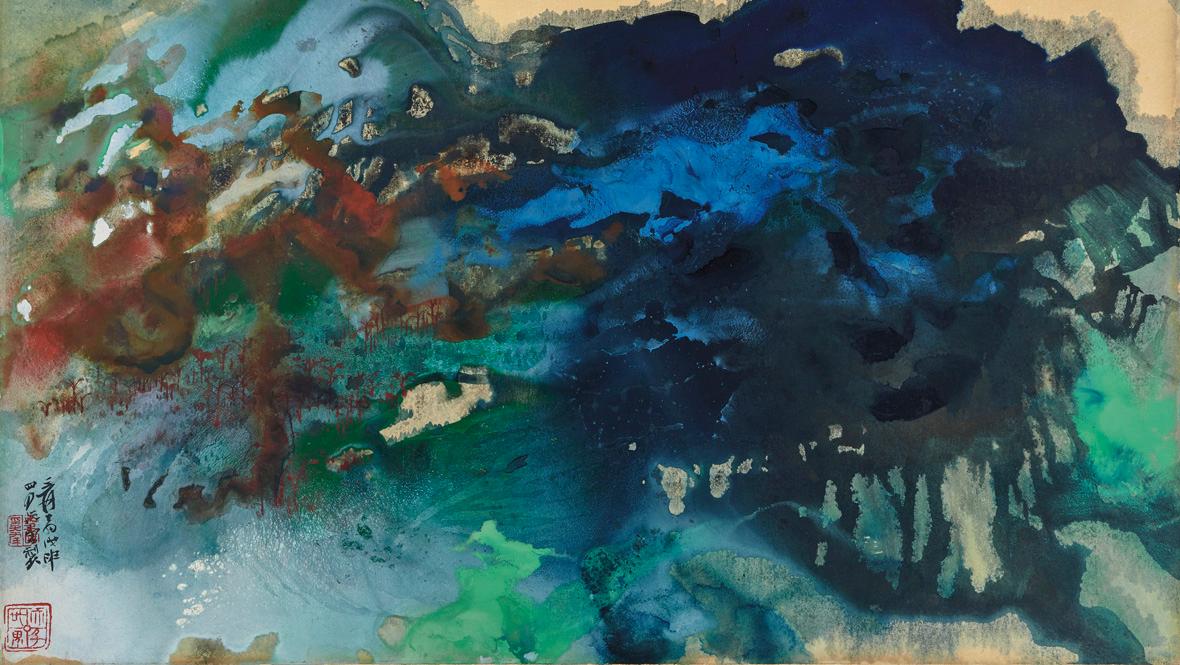Two years later, he resided in São Paulo, Brazil. In the 1960s he settled in Carmel, California and toured extensively around Northern California. Chang's first California solo exhibition in 1967 at Stanford University attracted an opening reception crowd of a thousand. Finally he settled in Taipei, Taiwan in 1978. During his years of wandering he had several wives simultaneously, curried favor with influential people, and maintained a large entourage of relatives and supporters. He also kept a pet gibbon. He affected the long robe and long beard of a scholar.
A meeting between Chang and Picasso in Nice, France in 1956 was viewed as a summit between the preeminent masters of Eastern and Western art. The two men exchanged paintings at this meeting.
He made millions on his forgeries and after his death his works have escalated in value.
In this post, I have picked some of my favorites by Zhang Daqian.
His loose brush strokes are modern and free.
Below, is one of his abstract "landscapes". This piece, done in 1968, is titled "Autumn Mountains in Verdant Mist".
His loose brush strokes are modern and free.
Below, is one of his abstract "landscapes". This piece, done in 1968, is titled "Autumn Mountains in Verdant Mist".
I note his use of vibrant blues, greens, and blue-greens, some of my very favorite colors, too. The vibrancy comes from his use of mineral colors.
In 2016 alone, his works sold for more than $350 million dollars.
In 2016 alone, his works sold for more than $350 million dollars.
As his art matured, instead of focusing on details in a painting, he developed his mature splashed-ink technique called “Pocai” which combines abstract expressionism with traditional Chinese styles of painting. He painted with intense mineral colors and broad washes of layered ink.
Zhang maintained that such works, which he first made in Europe in 1956, derived from the "broken-ink" techniques of random splashing and soaking used by Tang-dynasty (618-906) artists, but it seems more likely that Western abstract art encouraged him to develop the Japanese technique of splashed colors that he had used in earlier works.
He welcomed the liberating effect of this painting mode, which gave a spontaneity to his compositions. In spite of their abstract qualities, however, these paintings remain resolutely descriptive of the natural world. On one landscape, Zhang applied ink and color in a seemingly random manner, then added contour lines and other details that transform the composition into a highly suggestive vision of storm—engulfed mountains illuminated by a burst of sunlight that has turned the somber clouds iridescent. He attributed this style in part to the splashed-ink technique of the ancient painter Wang Mo (died c.805) also known as Wang Qia.
Zhang Daqian is perhaps the most famous Chinese painter of the 20th century. Best known for his ability to paint in any Chinese style, he is also credited with creating a modern style of Chinese painting based on his innovative use of splashed ink and color. He especially admired the Originalist painters Bada Shanren and Shitao. Zhang learned all of the traditional Chinese painting techniques: xieyei (literally “writing the idea”), which employs free and spontaneous brushwork; gongbi, which features precise and detailed brushwork and coloring; mogu, or boneless painting, which creates form using color rather than outlines; and pomo, or broken ink painting.
There are many ideas as to why Zhang’s style changed as he entered his 60s. Some scholars argue that his painting became looser and more abstract because of his contact with the Abstract Expressionists in the 1960s. Others think he was influenced by the Japanese technique of splashed ink. Zhang himself claimed that this style was derived from the pomo technique of random splashing and soaking employed by Tang artists.







